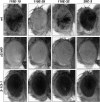Loss-of-function alleles of the JIL-1 histone H3S10 kinase enhance position-effect variegation at pericentric sites in Drosophila heterochromatin
- PMID: 17435241
- PMCID: PMC1894597
- DOI: 10.1534/genetics.107.073676
Loss-of-function alleles of the JIL-1 histone H3S10 kinase enhance position-effect variegation at pericentric sites in Drosophila heterochromatin
Abstract
In this study we show that loss-of-function alleles of the JIL-1 histone H3S10 kinase act as enhancers of position-effect variegation at pericentric sites whereas the gain-of-function JIL-1(Su(var)3-1[3]) allele acts as a suppressor strongly supporting a functional role for JIL-1 in maintaining euchromatic chromatin and counteracting heterochromatic spreading and gene silencing.
Figures


References
-
- Cryderman, D. E., M. H. Cuaycong, S. C. R. Elgin and L. L. Wallrath, 1998. Characterization of sequences associated with position-effect-variegation at pericentric sites in Drosophila heterochromatin. Chromosoma 107 277–285. - PubMed
-
- Deng, H., W. Zhang, X. Bao, J. N. Martin, J. Girton et al., 2005. The JIL-1 kinase regulates the structure of Drosophila polytene chromosomes. Chromosoma 114 173–182. - PubMed
-
- Girton, J., and K. M. Johansen, 2007. Chromatin structure and regulation of gene expression: the lessons of PEV. Adv. Genet. (in press). - PubMed
-
- Henikoff, S., 2000. Heterochromatin function in complex genomes. Biochim. Biophys. Acta 1470 1–8. - PubMed
Publication types
MeSH terms
Substances
Grants and funding
LinkOut - more resources
Full Text Sources
Molecular Biology Databases

